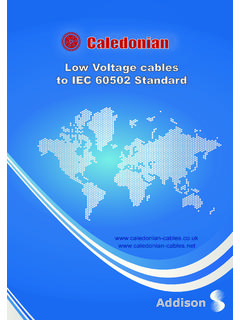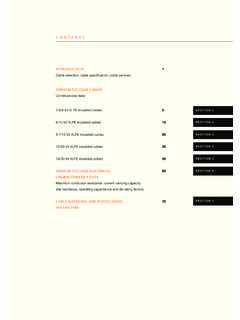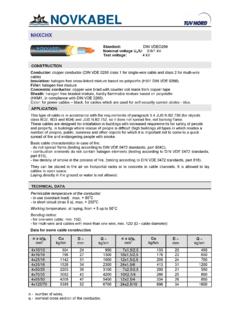Transcription of Fire Performance Standard - Addison Tech
1 fire Performance Standard At present, in cable industry, fire Retardant, Low Smoke halogen free (LSZH), Low Smoke Fume (LSF) and fire Resistant cables are all described as fire survival Cables. Flame Retardant fire retardant cables are designed for use in fire situations where the spread of flames along a cable route needs to be retarded. Due to relative low cost, fire retardant cables are widely used as fire survival cables. No matter the cables are installed in single wire or in bundles, during a fire , the flame spread will be retarded and the fire will be confined to a small area, thus reducing the fire hazard due to fire propagation.
2 Low Smoke & halogen free & fire Retardant ( LSZH). LSZH cables are not only characterized by the fire retardant Performance but also by the halogen free properties, thus offering low corrosivity and toxicity. During a fire , the LSZH cables will emit less smoke and acid gases which may damage the human being and expensive equipment. Compared with normal PVC cables, LSZH cables outperform by their fire retardancy, low corrosivity and low smoke emission properties, however, normal PVC cables have better mechanical and electrical properties. Low Smoke Fume (LSF). The low halogen content and low corrosivity of low smoke fume cables lies somewhat in between that of fire retardant cables and LSZH cables.
3 LSF cables also contain halogen but the content is much less than that of PVC cables. LSF cables are designed to reduce the spread of fire , toxic gases and smoke during fire . The LSF cables are usually manufactured from flame retardant PVC blended with HCL additive and smoke absorbent. These materials help improve the fire Performance of the LSF cables. fire Resistant (FR). fire resistant cables are designed to maintain circuit integrity of those vital emergency services during the fire . The individual conductors are wrapped with a layer of fire resisting mica/glass tape which prevents phase to phase and phase to earth contact even after the insulation has been burnt away.
4 The fire resistant cables exhibit same Performance even under fire with water spray or mechanical shock situation. fire Performance Class The main concerns for the cables in their fire survival properties are their flame spread, smoke characterization and gas toxicity. In American fire Standard , the concern lies more on the first two and it differs from the European Standard which concerns all these aspects. In USA, it is believed that the fire hazard is mainly due to CO toxic gas emitted and the heat release during the conversion of CO to CO2 during the fire . Therefore, to control the heat release is the most important concern for reducing the fire hazard.
5 However, in European countries, halogen content, the corrosivity of the gases, the smoke density and the toxicity of the gas are equally important factors affecting the safety and survival of human during a fire . 67 fire Performance Standard IEC Standard for Flame Retardancy The European Electrical Committee categorizes the fire Performance of the cables into three classes, namely IEC 60332-1, IEC 60332-2, IEC 60332-3, IEC 60332-1 and IEC 60332-2 are used to assess the flame propagation characteristics of a single wire. IEC 60332-3 is used to assess the flame propagation characteristics of bundled cables. Comparatively speaking, IEC 60332-3 for bundled cables is more demanding than IEC 60332-1 for single wires.
6 IEC 60332-1/BS 4066-1 (Flame Test On Single Vertical Insulated Wires/Cables). This test details a method of test for the assessment of the flame propagation characteristics of a single wire or cable. In this test, a 60cm cable sample is fixed vertically inside a metallic box and a 175mm long flame is applied at 45 from a gas burner placed at 450mm from the top at the upper portion. The specimen is deemed to have passed this test, if after burning has ceased, the charred or affected position does not reach within 50mm of the lower edge of the top clamp which is equivalent to 425mm above the point of flame application.
7 The test method is not suitable for the testing of some small wires due to the melting of the conductors during the time of application of the flame. IEC 60332-3/BS 4066-3 (Flame Test On Bunched Wires/Cables). IEC60332-3C describes a method of type approval testing to define the ability of bunched cables to resist fire propagation. In this test, a cable specimen, consisting of number of length of cables are fixed to a vertical ladder tray where they are applied with a flame from a gas burner for a specified times under controlled air flow. Four categories (A, B, C & D) are defined and distinguished by test duration and the volume of non metallic material of the sample under test.
8 The cable specimen is deemed to have met the requirements of the Standard if, after burning has ceased, the extent of charred or affected portion does not reach a height exceeding above the bottom edge of the burner. fire Performance Standard 68. UL Standard for fire Retardancy If a cable can pass a specified UL fire Standard , an UL Performance verification mark can be applied onto the cable jacket illustrating both the UL class and the number. There are five primary fire testing standards as follows. CMP (Plenum Flame Test/ Steiner Tunnel Test). Plenum rated cables meet the NFPA -262 Standard (formerly known as UL910).
9 Which provides the most stringent requirement of all the tests. Cable samples on a horizontal tray in a tunnel type of chamber are burned at (300,000 BTU/Hr) for 20 minutes. To qualify for a plenum rating the cable specimen musthave the flame spread of less than 5 feet or meters with a smoke density during the test of (a) peak and maximum average. The CMP cables are usually installed in air ventilation ducts and air returns widely used in Canada and USA. The fire retardant properties of CMP cables are much better than that of normal LSZH cables complying with IEC 60332-1 and IEC. 60332-3. CMR (Riser Flame Test).
10 Riser rated cables meets UL1666. Cable samples on a vertical shaft are burned at (527,500 BTU/Hr) for 30 minutes. To qualify for a riser rating, cable specimen must have the flame spread of less than 12 feet beyond the ignition point. This test does not look at the smoke density or toxicity. Riser rated cables are suitable for vertical shafts not defined as an environmental air plenum. CM (Vertical Tray Flame Test). General purpose cables meet UL 1581. Cable samples on a 8 feet vertical tray are burned at 20KW (70,000 BTU/Hr) for 20 minutes. The cable specimen is deemed to pass the test if the flame spread will not extend to the upper portion and extinguish by itself.






